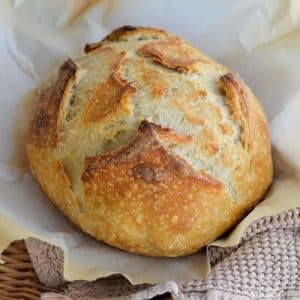
Sourdough Bread
This homemade sourdough bread is made with just a few simple ingredients: flour, water, salt, and a sourdough starter. The long fermentation process gives it a tangy, flavorful taste, while the high-heat baking ensures a crispy crust and soft, airy crumb. Whether you’re a seasoned baker or just starting out, this recipe will guide you through making your own sourdough loaf from scratch. Perfect for sandwiches, toast, or enjoying with a slice of butter, this bread is the definition of rustic comfort.
Equipment
- 1 Dutch oven (or baking stone)
- 1 Large bowl for mixing
- 1 Proofing basket (or bowl lined with a kitchen towel)
- 1 Razor blade (or sharp knife for scoring)
- 1 Kitchen towel or plastic wrap for covering the dough
- 1 Cooling Rack
Ingredients
- 3 cups bread flour
- 1 ¼ cups water room temperature or slightly warm
- ½ cup sourdough starter active and bubbly
- 1 tsp salt
Instructions
- Prepare the starter: Ensure your sourdough starter is active and bubbly before beginning.
- Mix the dough: In a large bowl, combine 3 cups of bread flour with 1 ¼ cups of water. Stir until the dough begins to form. Allow it to sit for 30 minutes.
- Add starter and salt: After the autolyse phase, mix in ½ cup of sourdough starter and 1 teaspoon of salt. Stir until fully combined.
- Knead the dough: Knead the dough for 10 minutes until smooth and elastic, or use the "stretch and fold" method for better control over the dough texture.
- Bulk fermentation: Place the dough in an oiled bowl, cover, and let it rise for 4-6 hours, performing stretch and folds every hour.
- Shape the dough: Turn the dough out onto a floured surface and shape it into a tight round or oval loaf.
- Proof the dough: Place the shaped dough into a well-floured proofing basket and cover it. Let it rise for 1-2 hours.
- Preheat the oven: Preheat your oven to 475°F (245°C) with a Dutch oven inside.
- Bake the bread: Once the dough is ready, carefully transfer it to the hot Dutch oven, score the top, and bake covered for 20 minutes. After 20 minutes, remove the lid and bake for an additional 25-30 minutes, until the bread is golden brown.
- Cool the bread: Let the bread cool on a wire rack for at least an hour before slicing.
Notes
- Starter Health: A healthy, bubbly starter is essential for the rise and flavor of the bread. Ensure your starter is fed and active.
- Autolyse: The rest period before adding salt and starter helps improve dough hydration and gluten development.
- Hydration: The dough should feel tacky but not too sticky. If it’s too sticky, add a little more flour; if it’s too dry, add a touch more water.
- Slow Rise: Letting the dough rise slowly enhances the flavor. You can refrigerate the dough overnight for an extended fermentation process.
- Crust: For a crispy crust, bake the bread in a preheated Dutch oven to trap steam and give the bread a golden finish.